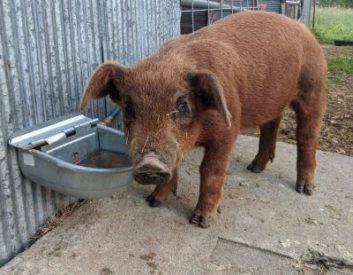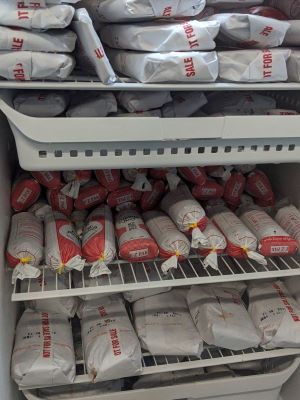By Margo Hale, NCAT Southeast Regional Director, Armed to Farm Program Director, and Agriculture Specialist
Last week, I shared a few thoughts about getting started with livestock.
In the Getting Started with Livestock Podcast, NCAT Livestock Specialist Linda Coffey and I discussed our farm goals, how our livestock enterprises help us meet those goals, and how the goals influence our livestock management. On my family’s farm, we want our livestock to make money, so we are always looking for cost-saving ideas. We also want our livestock enterprises to be easily managed without too much labor. We are a busy family and have focused on time- and money-saving systems.
I want to share with you a few pieces of infrastructure and equipment we have on our farm, why they work for us, and ways they don’t work. I always find it helpful to see how other farmers feed and water their animals. Maybe you will get ideas that you can implement on your farm—or you can send me ideas for improvement.
Watering Systems
As Linda and I discussed in the podcast, providing water is one of the first things you must figure out. On our farm we have a pond, a well, and county water. We also collect rainwater from our barn and sheds. We use all these resources to water our animals on different parts of our farm, depending on how we have our pastures divided and animals separated.
We try to find cost-effective ways to do most everything on our farm, so we like to use recycled materials and captured rainwater as much as possible. In one of our pastures, we have gutters on part of a shed and small shelter that empty into a tub. One of our friends had new gutters installed on her house and gave us the old gutters to use around the farm.


We did have a regular stock tank here, but it was too tall for our young goats to reach. We had an old IBC tote that we weren’t using, so we cut it in half to use as a waterer. This works great for the goats, but when cows are in this pasture, they tend to stand in these low totes, dirtying the water. It doesn’t take much rainfall to fill this water tub. We do have a water hydrant nearby that we can use to fill the tubs if there hasn’t been enough rainfall.

We have a small pasture next to our barn that we use when we have pigs and when our goats are kidding. Our free-range laying hens like to hang out in the barn, so they use this waterer, too. There is a 55-gallon barrel that captures rainwater and fills the bowl waterer, pictured above. The gravity-fed bowl is mounted over a small concrete pad, so the animals (pigs especially) don’t make a muddy mess around the waterer. We don’t often graze our cows in this small pasture, but when we do, this waterer doesn’t work too well. Several cows can empty that 55-gallon barrel quickly!
We use a similar set-up at our chicken coop (pictured above right). We have a coop with nest boxes and an enclosed run built on the back side of our shop. The hens have free range of our pastures, but we shut them in the coop at night. Once again, we use gutters on their coop roof, draining in to an elevated 55-gallon barrel. There is a hose from the barrel to a water bowl with a float. Our winters are fairly mild so we can use this system year-round. On occasion, the bowl and hose freeze and we have to carry water to the chickens. We have used this for our flock of about 20 chickens for about seven years, and I’ve only had to put water in the barrel a couple of times.
Hay-feeding Systems
We are in hay-feeding season on our farm, so I will share with you the equipment we use to feed hay.

We use a hay ring (above) to feed our cows, but this is problematic if you have goats or sheep. We have a few young goats with our cows right now to keep them away from our billy. They prefer to eat standing on top of the hay, soiling the hay and causing a lot of waste.

We have an elevated, round bale feeder that we use for our goats. This keeps the hay off of the ground and the goats cannot get on top of it. The cows are able to easily eat out of it, too. This reduces the amount of hay they waste.

We also have an elevated square bale feeder. We don’t feed many square bales (remember we want low labor), but do use them when we have goats in a small pasture right after they have kidded or are just feeding a few goats. Once again, keeping the hay off of the ground reduces waste.
We move the hay feeders to a different spot each time we feed a bale, typically feeding on an area that needs some extra fertility. There are many different ways to feed hay, but this is what works for us on our farm. Unrolling round bales is a great practice, but we don’t have enough animals for that to be efficient. They would waste too much before eating the majority of the bale. We have rolled out smaller portions of a round bale, but that was time-consuming.
Learning More
There is always trial and error before you figure out what systems work on your farm. I hope this virtual tour of our farm’s watering and hay-feeding systems will help you find what will fit your situation.
The ATTRA Sustainable Agriculture publications linked below have information about infrastructure and equipment for different livestock enterprises. As always, our NCAT Livestock Specialists are available to answer your questions and provide you with additional resources. Please email or call us at askanag@ncat.org or 800-346-9140.
ATTRA Resources
Small-Scale Livestock Production
Sheep and Goats: Frequently Asked Questions
An Illustrated Guide to Sheep and Goat Production
Hogs: Pastured and Forested Production
Poultry: Equipment for Alternative Production
Intensive Grazing: One Farms Setup (video series: Nine Chapters)
Photos by Margo Hale

 You might be able to gain new customers during this time, as people are wanting to stock their freezers and prepare for supply-chain disruptions. You want to ensure that these new customers continue purchasing from you even after the grocery stores are restocked. In order to do this, you must provide an excellent product and good customer service. It is tempting to quickly scale up production to take advantage of the demand, but don’t do so at the cost of quality. Don’t process and sell animals that don’t meet your highest quality standards. Providing great customer service is another way to keep customers coming back. NCAT Specialist Dave Scott and his wife Jenny shared some really great tips on providing excellent customer service to their meat customers in the “Direct Marketing Meat” podcast series.
You might be able to gain new customers during this time, as people are wanting to stock their freezers and prepare for supply-chain disruptions. You want to ensure that these new customers continue purchasing from you even after the grocery stores are restocked. In order to do this, you must provide an excellent product and good customer service. It is tempting to quickly scale up production to take advantage of the demand, but don’t do so at the cost of quality. Don’t process and sell animals that don’t meet your highest quality standards. Providing great customer service is another way to keep customers coming back. NCAT Specialist Dave Scott and his wife Jenny shared some really great tips on providing excellent customer service to their meat customers in the “Direct Marketing Meat” podcast series. Another challenge many livestock producers are facing is the lack of processing. Access to meat processing facilities has always been a challenge for small-scale livestock producers. The problem has been exacerbated during the pandemic. Producers are increasing production in response to increased demand for direct-to-consumer meat sales—which means there are more animals to process in facilities that already have limited availability. For example, I can usually call just a couple of months in advance to schedule a processing date for our animals; I called our processor in May and the earliest dates they had were in January 2021! Our hog will be awfully big by then. If you are a livestock producer and haven’t already booked your processing appointments for the coming year, I encourage you to call your processor today. I had a great conversation with Rebecca Thistlethwaite with the
Another challenge many livestock producers are facing is the lack of processing. Access to meat processing facilities has always been a challenge for small-scale livestock producers. The problem has been exacerbated during the pandemic. Producers are increasing production in response to increased demand for direct-to-consumer meat sales—which means there are more animals to process in facilities that already have limited availability. For example, I can usually call just a couple of months in advance to schedule a processing date for our animals; I called our processor in May and the earliest dates they had were in January 2021! Our hog will be awfully big by then. If you are a livestock producer and haven’t already booked your processing appointments for the coming year, I encourage you to call your processor today. I had a great conversation with Rebecca Thistlethwaite with the